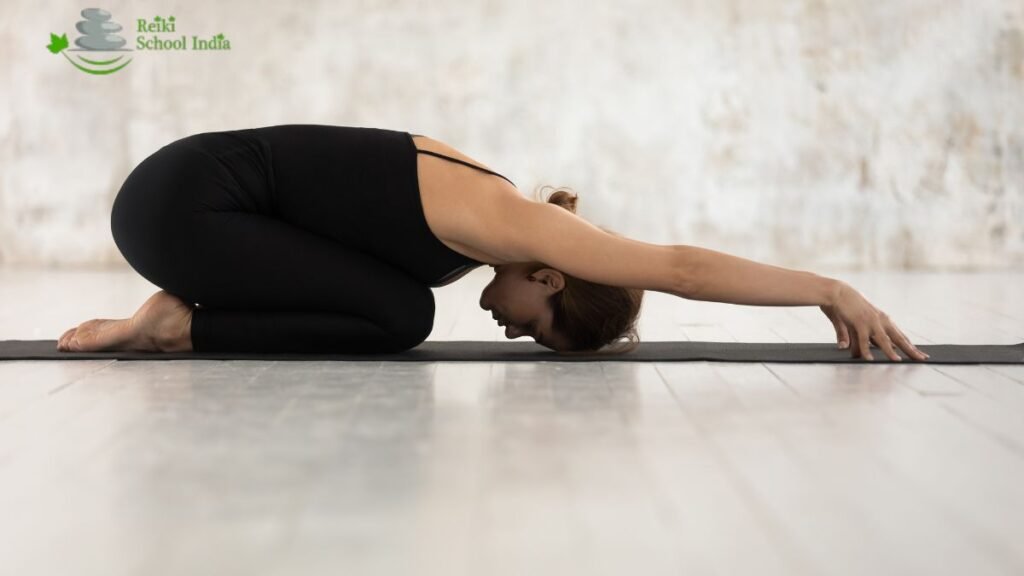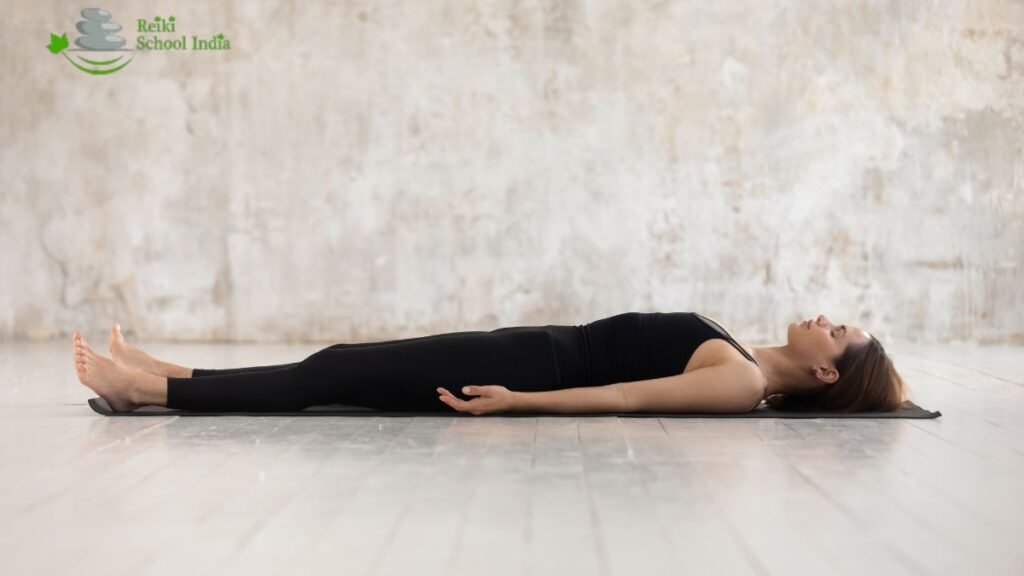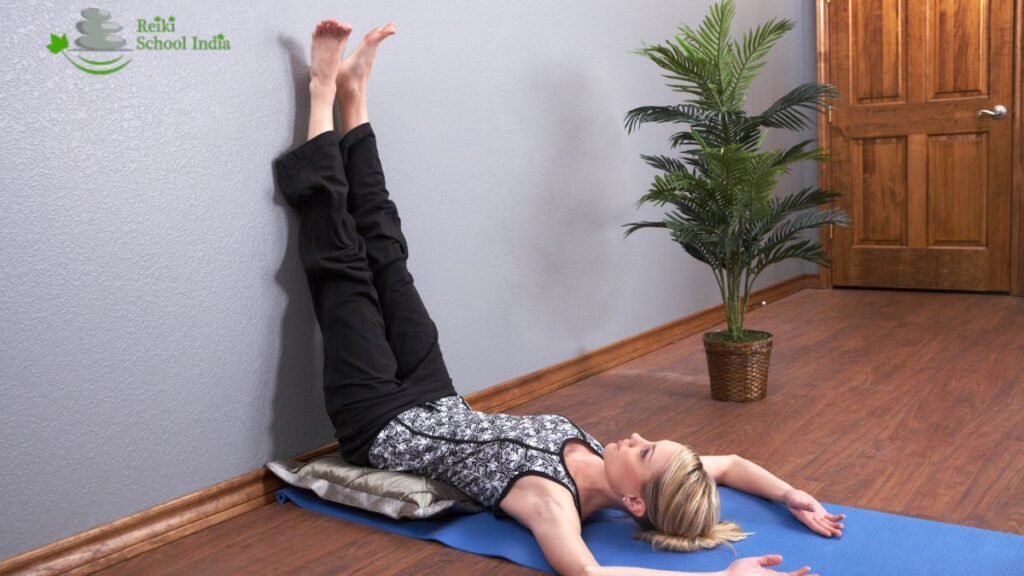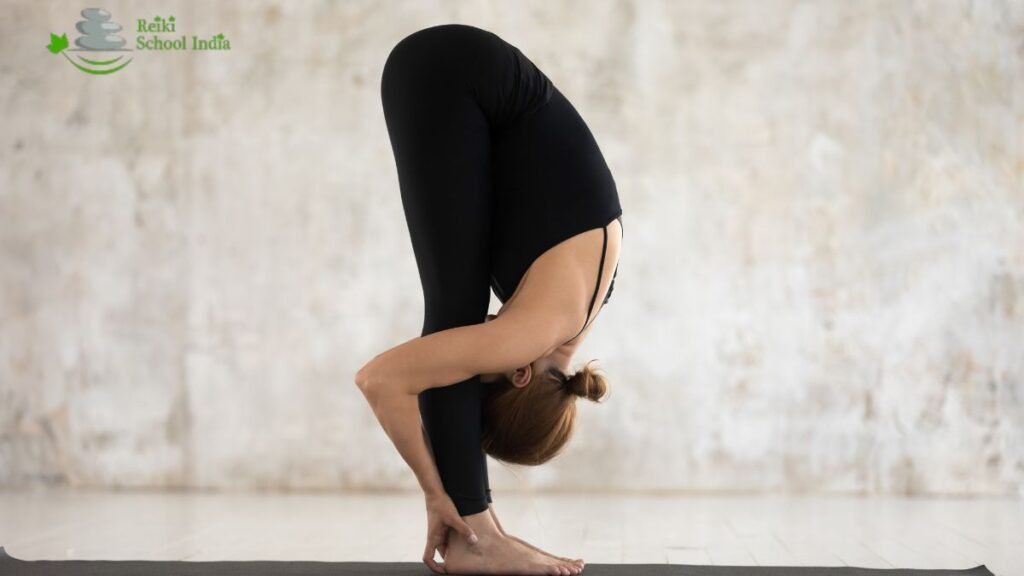Welcome to Reiki School 🧘,in this blog we will discuss about Yoga for Better Sleep Patterns.In the modern whirlwind of daily life, deep, restorative sleep can often feel like the elusive treasure at the end of an arduous quest. Sleep is not only a time for our bodies to rest and recharge but also a crucial period for our minds to process the day’s events and ensure cognitive well-being. Yet, stress, anxiety, and the omnipresent glow of screens can all conspire to keep us wide-eyed at night, yearning for just a few moments of uninterrupted rest.
Enter yoga—a practice that has quietly offered millions a serene and undisturbed passage to the land of dreams at Aatm Yoga Shala. But just how does the ancient art of yoga guide our weary selves to the shores of good sleep? Join us as we explore the powerful practices and postures that promise to rewrite the narrative of our nightly rest.
Yoga for Better Sleep Patterns With Poses Names
Yoga Sleeping Pose Name
Incorporating yoga into your nightly routine can be a game-changer for improving the quality of your sleep. Certain poses, known for their calming and restorative effects, can be particularly beneficial when done before bedtime. Here are a few to consider:
- Balasana (Child’s Pose): This gentle forward fold is perfect for releasing tension in the back, shoulders, and chest, promoting relaxation and helping to alleviate stress.
- Supta Baddha Konasana (Reclining Bound Angle Pose): Lying on your back, allow your knees to fall open, bringing the soles of your feet together. This pose helps to open the hips and relax the pelvic area, where stress and tension often accumulate.
- Viparita Karani (Legs Up the Wall Pose): By elevating your legs against a wall, this pose encourages circulation, eases leg swelling, and calms the nervous system, making it easier to drift off to sleep.
- Savasana (Corpse Pose): Though often used at the end of a yoga practice, Savasana can also be a powerful pre-sleep pose. It’s an opportunity to rest in a state of total relaxation, preparing the body and mind for deep sleep.
5 Yoga for Better Sleep Patterns
1. Child’s Pose (Balasana)

How to Do It
- Kneel on the floor with your feet together and sit back on your heels.
- Inhale and raise your arms overhead.
- Exhale as you bend forward, draping your torso over your thighs.
- Allow your forehead to rest on the ground, and extend your arms forward with palms facing down.
- Hold the pose, taking deep breaths to expand your back with each inhale.
The Sleep Benefits
Child’s Pose gently relaxes the muscles of the back, hips, and thighs. It also encourages deep breathing, which can calm the mind and prepare the body for sleep. By directing your attention inward, Child’s Pose helps to switch off mental chatter and focus on the present, an essential step towards lulling the active mind into rest.
2. Corpse Pose (Savasana)

How to Do It
- Lie flat on your back with your legs extended and arms at your sides.
- Allow your feet to flop outwards, and your hands to be open, with your palms facing upwards.
- Close your eyes and breathe deeply, scanning your body for any remaining tension.
- Relax each muscle group, starting with the toes and working up to your head.
- Stay in Savasana for at least 5-10 minutes, breathing long and deep through your nose.
The Sleep Benefits
Savasana is the pose of surrender and complete relaxation. It allows for a conscious letting go of physical and mental tension, which is especially important for those who hold stress in their bodies. By entering a state of deep relaxation, this pose can significantly decrease cortisol levels and provide an effective transition to sleep.
3. Legs Up the Wall Pose (Viparita Karani)

How to Do It
- Sit with one side of your body against a wall.
- Shift your weight to the side, and as you do, use your hands to support you and lift your legs up the wall.
- Your sitting bones should be as close to the wall as possible, and your body should make an “L” shape.
- Rest your arms at your sides or place them on your belly or chest.
- Close your eyes and breathe deeply, holding the pose for 5-15 minutes.
The Sleep Benefits
This gentle inversion can soothe the nervous system and decrease blood pressure, making it an effective pre-sleep practice. It also facilitates venous blood and lymphatic fluid from the legs and feet flow back to the heart, which can reduce swelling and help alleviate restless legs syndrome and insomnia.
4. Standing Forward Bend (Uttanasana)

How to Do It
- Begin in a standing position with your feet hip-width apart.
- Exhale and lengthen your torso forward, bending at the hips.
- If your spine is flexible, your fingertips may touch the floor. Otherwise, you can place your hands on your shins or thighs.
- Your head should hang freely, and your weight should be slightly forward, into the balls of your feet.
- Breathe deeply and hold for a minute or two, then slowly rise up on an inhale.
The Sleep Benefits
This pose provides a gentle stretch to the entire backside of your body, including the spine, hamstrings, and calves. It can alleviate tension and reduce the debilitating effects of stress on the body. The inversion of Uttanasana also encourages the flow of blood to the brain, which has a calming effect on the nervous system and can help with sleeplessness.
5. Seated Forward Bend (Paschimottanasana)

How to Do It
- Sit on the floor with your legs extended in front of you.
- Inhale and extend your arms overhead.
- Exhale and bend forward from the hips, keeping the spine long.
- Grasp your feet, shins, or use a strap, to maintain the length of the spine.
- Relax your head and neck, and breathe deeply for 1-3 minutes.
- Inhale as you rise back up to a seated position.
Yoga for Sleep and Anxiety
- Yoga combines physical postures, breathing exercises, and meditation for overall well-being.
- Helps combat sleep issues and anxiety by quieting the mind and reducing stress.
- Improves sleep quality through rhythmic breathing and focused attention.
- Encourages mindfulness to reduce rumination on past or future worries.
- Incorporating yoga into nightly routine aids in transitioning to sleep naturally.
- Reduces stress levels and calms the nervous system, benefiting sleep and anxiety management.
Additional 10 Sleeping Yoga Asanas for Improved Rest and Relaxation
- Pigeon Pose (Eka Pada Rajakapotasana)
- Butterfly Pose (Baddha Konasana)
- Happy Baby Pose (Ananda Balasana)
- Cat-Cow Stretch (Marjaryasana-Bitilasana)
- Supine Twist (Supta Matsyendrasana)
- Bridge Pose (Setu Bandhasana)
- Forward Fold (Uttanasana)
- Supine Spinal Twist (Jathara Parivartanasana)
- Plow Pose (Halasana)
- Reclining Hero Pose (Supta Virasana)
Integrating Yoga for Sleep into Your Nightly Routine
The key to using yoga for sleep is consistency. Establishing a routine and performing these calming poses at roughly the same time each night can signal to your body that it’s time to unwind. Transitioning directly from other nighttime habits like reading, dimming the lights, or reducing screen time can further enhance the effectiveness of your practice. Beginning with a short sequence of 15-20 minutes is a manageable commitment that can yield significant benefits. Remember, the aim is to create a gentle transition to sleep and not to overexert the body with vigorous exercise.
Sleeping yoga asanas names
In addition to the primary poses listed, here are the names of some beneficial sleeping yoga asanas that can enhance rest and relaxation:
- Pigeon Pose (Eka Pada Rajakapotasana)
- Butterfly Pose (Baddha Konasana)
- Happy Baby Pose (Ananda Balasana)
- Cat-Cow Stretch (Marjaryasana-Bitilasana)
- Supine Twist (Supta Matsyendrasana)
- Bridge Pose (Setu Bandhasana)
- Forward Fold (Uttanasana)
- Supine Spinal Twist (Jathara Parivartanasana)
- Plow Pose (Halasana)
- Reclining Hero Pose (Supta Virasana)
These asanas are specifically chosen to help the body unwind, alleviate stress, and encourage a peaceful transition into sleep. By integrating these poses into your nightly routine, you can foster a deeper sense of relaxation and significantly improve the quality of your rest.
In Conclusion Yoga for Better Sleep Patterns
Yoga offers a toolkit for building resilience against the frenetic pace of our lives. By integrating these practices into our daily routine, we not only stand to gain a wealth of health benefits but also carve out a sacred space for tranquility that paves the way for deep, rejuvenating sleep. There’s no one-size-fits-all approach, but with a willingness to explore, a community of like-minded seekers, and the seasoned wisdom of yogis and experts, the path to a night filled with sweet dreams is within reach.
To those still on the fence, the call to action is clear—maybe tonight’s the night to roll out your mat and unravel the beautiful mystery of how a few mindful breaths and intentional movements can lead to a night of undisturbed rest.
(FAQs)Yoga for Better Sleep Patterns
How long before bed should I practice yoga for sleep?
It is ideal to practice yoga 1 to 2 hours before your bedtime. This allows your body and mind enough time to relax and unwind, making it easier to fall asleep.
Can yoga replace sleep medications?
While yoga can significantly improve sleep quality and help manage symptoms of insomnia, it should not be used as a direct replacement for sleep medications without consulting a healthcare provider.
Is it safe to practice yoga for sleep during pregnancy?
Yes, many yoga poses are safe during pregnancy, specifically poses that do not put pressure on the abdomen. However, it is recommended to consult with a healthcare provider before starting or continuing a yoga practice during pregnancy.
How often should I practice yoga to see improvements in my sleep?
Consistency is key. Practicing yoga as part of your nightly routine, even if just for 15-20 minutes, can yield significant improvements in sleep quality over time.
Can children practice yoga for sleep?
Absolutely. Yoga can be a beneficial tool for children to help them relax before bedtime. However, the poses and duration of practice should be adjusted to suit their age and physical capabilities.







